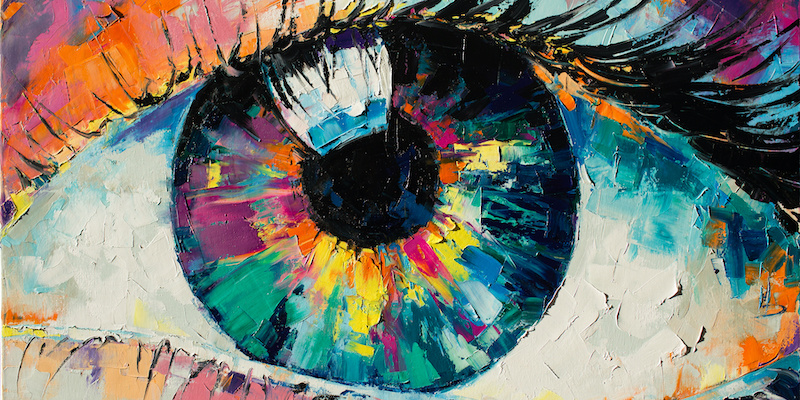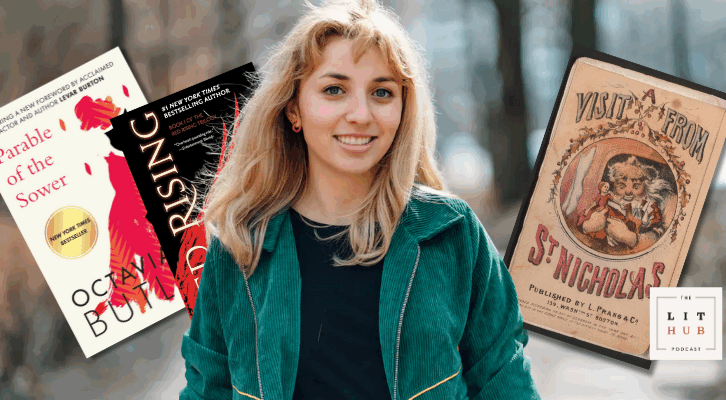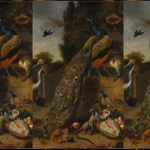We can thank the mistake. It’s the core reason why Claude Monet—the famed French impressionist painter—came to master his iconic depiction of shadows. For mystery writers, the “error” is especially instructive given our challenge to create the most shadowy of mystery characters: the villain.
Monet was flirting with the shady side, indeed, when he and Pierre-Auguste Renoir sneaked away from the claustrophobic confines of their in-studio painting class (along with pals Alfred Sisley and Frédéric Bazille) to go outside and paint French life en plein air.
It was 1862, and theirs was artistic defiance of the highest order—a blatant rejection of tradition and protocol. Studio painting, with its controlled lighting and staged subjects, was considered academic art’s crème de la crème. Monet and his buddies found it stale and old-fashioned.
In the dappled sunshine outdoors, however, Monet and friends cast their artistic eyes on the moment-to-moment movement, light, colors, and dynamism of real French life. For them—along with their mentor Édouard Manet, and soon Paul Cézanne and Camille Pissarro—there was no turning back.
In their “impressions” of immediate life, a movement was born.
Says Sheehan Quirke, the Cultural Tutor on Twitter, “They didn’t paint reality as a camera might capture it, but as the eye perceives it from one moment to the next with all its movement, changing light, sudden glimpses, fog, and blur.” Even as early impressionists, they didn’t see shadows as a beginning mystery writer might—as a dark stain on a bright landscape, without nuance, variance, or multidimensional context.
In fact, one day—as the story goes—painter John Singer Sargent was painting with Monet and asked, “Where’s the black?”
Monet’s reply: “I don’t allow myself to use black. It’s against the impressionist theory. In nature, all colors are made by mixing.”
Sargent considered that a mistake. But through that “error,” Monet had forced himself to look more astutely at shadows and the ever-changing light surrounding them. As he saw it, the atmosphere—including its shadows—was awash in hues of blue. Indeed, Monet’s favorite color for painting shadows? Violet. Sometimes muted. Sometimes bright. For him, a shadow was never just flat black.
In that way, says historical mystery novelist Nev March, “a good villain can’t be just black-and-white, but more nuanced.” Enter some violet, indeed. Not to mention more assortment among all characters, not just villains.
Monet shows writers how to “paint” with varied subtlety in such famed shadowed images as A Pathway in Monet’s Garden and Woman with a Parasol—Madame Monet and Her Son. Under a parasol, the shadowed face of Monet’s wife, Camille, is also further veiled. Still, her eyes penetrate the windswept scene. Though muted in shadow, she becomes impossible not to notice.
Cézanne, in fact, came to realize that our eyes are not static when we look, “but are making minuscule darting movements (known as ‘saccades’) between areas of visual interest,” writes Matthew Wilson of the BBC. Focusing his gaze on subjects for long minutes gave them mask-like faces (Madame Cezanne in a Yellow Chair) as he concentrated on small areas of facial detail not as a holistic whole.
His approach offers an intriguing way to set apart a villain, such as the permanently frozen smile of Charles Augustus Milverton in The Return of Sherlock Holmes. “The worst man in London,” Holmes declared.
Meantime, artist Henry O. Tanner, the esteemed nineteenth- and early twentieth-century African American painter, gained international acclaim, in part, with his subtle use of chiaroscuro (dark-light contrast)—applied not to explore what was in the shadows, but what a single light source in a shadow revealed. Moving to Paris in 1891 to study, this son of an ordained minister was drawn to religious imagery, using blue-washed shadows in such works as Daniel in the Lions’ Den—which was accepted in the 1896 Salon, the official art exhibition of the Académie des Beaux-Arts in Paris.
In The Good Shepherd and The Miraculous Haul of Fishes, his images weren’t biblically literal. Rather, says the High Museum, “he distilled their spiritual essence by reducing all representative details,” giving them, said Tanner, “the human touch which makes the world kin.”
Nuanced reduction also dominates Monet’s oversize water lily paintings and, notably, the thirtysome “Haystacks” impressions he painted in a field near his house at Giverny, including the arresting Haystacks (Effect of Sun and Snow).
Shadows par excellence, however, mark Monet’s haystack masterpiece Meules—its setting sun rinsing the shadow side of ordinary haystacks in delicate strokes of violet. When the piece sold at auction in 2019 for a jaw-dropping $110.7 million, six bidders “fought fervently” in just eight minutes, reported the auction house Sotheby’s, for the Monet masterwork.
And his buddy Renoir?
In his famed scenes of intimate joy, mystery writers can unearth stunning and ironic insight for crafting shadows, as in his captivating Dance at Le Moulin de la Galette—whose shadows feature the happy lightest of pale blues, not just somber darkest navy—and in his sensually colorful Dance at Bougival.
The latter painting, acquired by MFA Boston in 1937, depicts a super suave boatman—on his day off apparently—dancing exceedingly close with a flushed young woman across a dance floor littered with cigarettes, burnt matches, and a small bouquet of purple flowers. Is the young man a rogue? Indeed, a villain?
Renoir, the son of a dressmaker and tailor, answered by capturing—as he adored to do—the intricate details of his characters’ clothing. Nothing in the painting expresses a bit of dangerous villainy, in fact, more than the boatman’s sassy straw hat and the showy but slightly worn, two-toned, spectator shoes painted in a faintly greenish shadow. The young lady’s prim black pump, hardly seen, can’t compete. Other men in formal top hats appear irrelevant. The painting’s possible message? Mama, don’t let your babies go dancing with sartorially defiant French boatmen.
What else do these and other painters teach artistically challenged mystery writers about what’s in the shadows? Especially regarding our villains?
First, the best shadowy figures don’t exist alone. They reflect, literally, the bright world and colors around them, even if garish.
Artist Will Kemp, whose popular online tutorials impart artistic technique, explains why. “Shadows help to ‘ground’ an object and learning to accurately observe them is the most effective way of making your paintings look convincing.”
In that same way, a novel—like a painting—is only as good as its shadows (or villains) and what’s around them. “Beginners tend to focus on the main subject they’re trying to draw or paint,” Kemp says, “whereas artists will often look at the shapes around the subject—called the negative space—and the shapes being cast by the subject.”
Thus, Nev March’s villain in her debut mystery, Murder in Old Bombay (an Edgar Award finalist), needed to be “complex,” March said, “with a backstory and quirks as well as some positive aspects. It’s difficult to strike that balance between someone the reader will fear/hate who still has goals and reasoning that are credible and sometimes even laudable.”
Novelist Ausma Zehanat Khan, whose Blackwater Falls was a Publishers Weekly Best Mystery of 2022, crafts villains “under the pressure of deeply troubling circumstances to see what choices they will make. They’re often good people who don’t see a way out or who haven’t been able to get justice through the usual channels.”
Her favorite villain remains a character from her debut novel, The Unquiet Dead (released by Minotaur in 2015). “What’s been fascinating to me, all these years on, is that people simply don’t see that character as a villain, despite the murder that takes place. I think that has a lot to say both about how we perceive justice and what we’re willing to accept when there’s a total failure of justice.”
Nev March would agree. “Every character is the hero of their own story. This means that my novel could well be written from the villain’s POV. So having reasonable justifications for the villain’s actions certainly helps.” In her upcoming novel, The Spanish Diplomat’s Secret, protagonist Captain Jim encounters a villain who turns his thinking about right and wrong on its head. What makes a person willing to break the law, willing to take the law into their own hands, even knowing the consequences? Captain Jim battles an unconventional and desperate foe who will force him to rethink his most closely held beliefs.
Will Kemp uses a similar approach to draw. “When I’m drawing a bottle, I don’t draw the bottle. I draw the shapes around the bottle, and the bottle is drawn for me.” Aspiring artists fail, he said in his tutorial “The 3 Reasons Why You Can’t Draw,” because they “talk too much,” labeling an object bottle—just as a novelist might label the bad guy villain.
Instead, consider the light source shining on the shadow. How does that change how the shadow looks, acts, moves, speaks?
Anthony Horowitz’s modern-day villain in his mystery-within-a-mystery Magpie Murders is such a shape-shifter. Discovering the villain’s identity feels unforced and right after we’ve spent so much benign time around his shadow throughout the course of the story. Rendered good and safe by the positive and earnest light of protagonist Susan Ryeland, the villain’s true nature and motivation remain hidden until the cunning is finally revealed in bright, confident strokes—painted by editor–turned–amateur sleuth Ryeland—that feel artistically satisfying.
Monet and Renoir and the other impressionists used this same approach by starting with brighter canvases. “Normally, they were dark gray,” says Sheehan Quirke (The Cultural Tutor). “But by the end, Monet and company were using white canvases.”
Artist Jacob Lawrence, the African American creator of his famed “Migration Series,” rewrote that approach by using black prominently—but not for shadows, juxtaposed instead with bright colors painted straight from the tube, his preference. Thus, blinding white was his choice to paint the fancy suit worn by a planter whipping a Haitian slave in his series “The Life of Toussaint L’Ouverture,” No. 7 and No. 10. That white clothing seems to leap from the canvas, bringing to mind the awful probability of the suit being streaked in red blood before the whipping ends.
In contrast, Kerry James Marshall, a contemporary African American artist, paints Black representation with such intention and joy that shadow colors include bright greens, blues, reds, yellows. If any villains reside in his painterly world, they’re having a colorfully good time, such as in Past Times, which in 2018 sold at a Sotheby’s auction for $21.1 million.
As such, Agatha Christie’s least popular villains seem to be dully horrific—such as the abusive psychopath in Towards Zero. In contrast, her most beloved villains tend to almost shimmer, nearly distracting Hercule Poirot, as with the guileful antagonists in Peril at End House, Death on the Nile, the iconic Murder on the Orient Express, and her masterwork, The ABC Murders.
Such stories capture perhaps the best artistic lesson for writers from master painters—remember to surprise. Thus, we’re stunned by the small gold cross hanging askew around the woman’s neck in Renoir’s seduction scene of In the Garden or the tiny baby swaddled in shocking white (foreground, stage left) in a Southern train station in Jacob Lawrence’s “Migration Series.”
Humbly, I aimed for surprise in my debut mystery, All That Is Secret, and its second installment, Double the Lies—set in the tension between the African American church world of Colorado’s 1920s Klan era and the complicit culture of the white elite. The debut recently won a Christy Award for first novel, giving me confidence in the third installment (in progress) to paint with even more subtle surprises, especially in the villain.
Kate Lansing took a similar route in her debut cozy culinary mystery, Killer Chardonnay. “I intentionally gave this character an innocent appearance, even describing her as more cherub than human at one point, purely for the juxtaposition of evil sometimes existing in those who seem the most innocuous.”
Similar to Nev March, Lansing always tries “to keep in mind that the villain should be the protagonist of their own story. They should grow and change through the course of the novel, even if their arc isn’t as apparent as that of the main characters.”
Such changes with villainy pay homage to the ever-changing quiet shadows of any impressionist masterpiece.
In his Nickel City mystery series, Gary Earl Ross crafts his two favorite villains—a white man in book 3, Nickel City Storm Warning, and a Black woman in book 4, Nickel City Naked Lady—who Ross says “couldn’t be more different on the surface.” But each is skilled “at quietly manipulating others.” Both are evil, Ross says, “but evil, like tea, steeps in a wide variety of flavors.”
Master painters invite us likewise to taste the varied palette available to us. Go outdoors, indeed. Look at the world. Among the bright hubbub, a villain awaits.
***


















